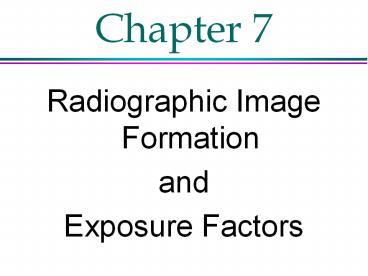Radiographic Image Formation - PowerPoint PPT Presentation
1 / 20
Title:
Radiographic Image Formation
Description:
In this section we will see how the image is formed on the x-ray and what are ... all of which combined determine the quality of the radiograph produced. ... – PowerPoint PPT presentation
Number of Views:2607
Avg rating:3.0/5.0
Title: Radiographic Image Formation
1
Chapter 7
- Radiographic Image Formation
- and
- Exposure Factors
2
Radiographic Image Formation
- In this section we will see how the image is
formed on the x-ray and what are the effects of
the various factors that we control before making
the exposure.
3
Radiographic Image Formation
- X-rays can pass through solid objects - the
degree of penetration depending upon the
wavelength of the rays and the composition of the
object. Some rays are completely absorbed the
others are absorbed in varying degrees. - The degree of absorption depends upon the type of
material, the thickness, and the atomic number of
the material that the x-rays must pass through.
4
Radiographic Image Formation
- Since the body is made up of many materials of
many various thicknesses, x-ray is absorbed in
varying degrees and therefore reaches the film in
varying degrees. This is how the x-ray image (or
shadow) is formed. X-ray is a shadow picture of
differential absorption. - This process is described in more detail in the
chapter on darkroom procedures.
5
Exposure Factors
- There are several factors involved in
radiography, all of which combined determine the
quality of the radiograph produced.
6
Exposure Factors
- They are
- Kilovoltage
- Milliamperage
- Exposure Time
- Milliampere-Second
- Film-Anode Distance
- Part-Film Distance
- Size of Focal Spot
7
Kilovoltage (Quality)
- Kilovoltage is the electromotive force or
electrical pressure that pushes the electrons
from the cathode to the anode during exposure,
therefore controlling the speed that the
electrons travel, the force of the impact at the
anode target and the quality of penetrating power
of the x-rays produced.
8
Kilovoltage
- The kilovoltage determines the wavelength of the
x-rays produced. High kV. produces short
wavelength x-rays (hard rays), the type with
great penetrability lower kV results in longer
wavelengths (softer rays) and less penetrability.
9
Kilovoltage
- We can then see that selecting the kV
predetermines the quality of the x-rays produced.
(the penetrating power of the beam). - The kV selected for the exposure depends upon the
thickness of the part to be x-rayed. A general
rule that has sometimes been used to determine
the kV is twice the thickness of the part, in cm,
plus 25.
10
Milliamperage (Quantity)
- Milliamperage determines the exact number of
electrons which will be forced from the cathode
to the anode in a specific amount of time and
under a specific kilovoltage. - This is explained by the fact that the MA applied
to the cathode filament determines its
temperature (its degree of incandescence) and
therefore the number of electrons that will be
boiled off.
11
Milliamperage
- It is the MA together with the time that
determines the total quantity of x-rays produced
for each electron that strikes the anode target,
there will be an equivalent amount of x-ray
energy produced.
12
Exposure Time (S) (Quantity)
- Exposure time is the length of time (in seconds)
that the anode target will be bombarded with
electrons and therefore during which x-rays are
produced. The exposure time and the amount of
x-ray produced per second (as determined by the
MA setting) determine the total amount of
radiation produced.
13
Milliampere-Second (MAS)
- Milliampere-second refers to the product of the
milliampere and the exposure time. It indicates
the total quantity of x-ray produced. The same
results will be had with high MA and low time or
low MA and high time. Low MA at longer time will
risk patient movement and result in a poor
quality film, therefore, high MA and low exposure
time is preferred.
14
Milliampere-Second (MAS)
- The MAS represent a combination of the MA and the
exposure time in seconds. For example, the MAS
used for a lumbosacral (A-P) is 10 and any of the
following combinations or any other combination
making 10 MAS could be used 10 MA for one
second, 30 MA for 1/3 second, 50 MA for 1/5
second, 100 MA for 1/10 second.
15
Film-Anode Distance (FAD)
- AKA Tube-Film Distance (TFD) AKA Focal film
Distance (FFD) - refers to the distance from the anode target to
the film. It governs radiographic distortion. The
shorter the FAD, the greater the distortion the
longer the FAD, the more nearly parallel the rays
and the less distortion or magnification.
16
Film-Anode Distance (FAD)
- The previous statement would seem to indicate
that we should always use an FAD as long as the
size of the room permits, but this is not so. An
increase in FAD reduces the overall illumination
so that the MAS must be increased.
17
Film-Anode Distance (FAD)
- This increases the possibility of the patient
moving if you only increase the time. - With modern day equipment you can increase the MA
and therefore less chance of patient movement
and better diagnostic yield. - It decreases the overall illumination due to the
inverse square law (so your technique factors
must be adjusted accordingly).
18
Part-Film Distance (PFD)
- AKA Object-Film Distance (OFD)
- The part-film distance should be as close to zero
as possible. An increase in the PFD/OFD will
cause distortion.
19
Size of the Focal Spot
- The size of the focal spot is determined by the
size of the filament (the surface area of the
wire filament capable of emitting electrons when
heated to incandescence). This is the size of the
electron stream. - The larger the filament, the larger the focal
spot. The larger the focal spot, the poorer the
film detail.
20
Range of Exposure Factors































